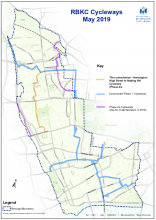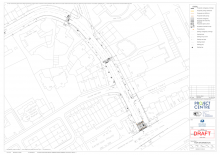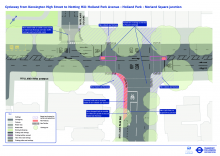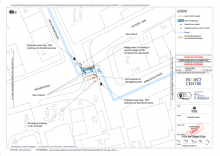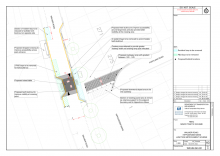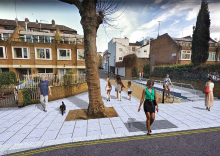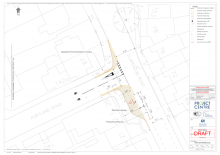Kensington High Street to Notting Hill Cycleway Consultation
On this page
Cycleway: Kensington High Street to Notting Hill
Public consultation
Encouraging cycling is one of the Council’s borough transport objectives. We want to make sure cycling is safe, easy, attractive and inclusive for all. We are also concerned about the impacts of poor air quality on our residents, and believe making cycle trips safer is part of the solution to providing alternatives to motor vehicle trips. We hope that new and existing cyclists alike will appreciate being able to use clear, direct routes along quiet side streets.
We are consulting on a new cycle route, linking Kensington High Street to the cycle route known as Quietway 2 in Notting Hill. It begins at Melbury Road, passes along Abbotsbury Road and Holland Park, crosses Holland Park Avenue into Norland Square, then travels along Queensdale Road, Princedale Road, Walmer Road/Portland Road, Clarendon Road and Blenheim Crescent where the route joins Quietway 2. In general, the measures that we are proposing are designed to reduce the speed and volume of traffic, reduce the risk of conflict at junctions and where cycle facilities already exist, upgrade them.
We are asking what you think of our proposals regarding the new Cycleway. Please read the following information carefully before filling in the below questionnaire no later than 12 June 2019. For further information, please email us at: [email protected] or call: 020 7361 3766.
Complete the consultation survey
Proposed changes
This north-south Cycleway scheme is intended to complement the scheme proposed by Transport for London along Holland Park Avenue and Notting Hill Gate (proposals can be viewed on the TfL website) but the two schemes are independent of each other: it would be possible to build either of them without building the other. This route is intended to be part of a longer north-south Cycleway. We will consult local residents on an extension southward across Kensington High Street when we have further investigated how this could be done.
On Melbury Road, where traffic speeds are on the high side, we are proposing two sinusoidal road humps and an entry treatment at the junction with Kensington High Street. Sinusoidal humps are designed so that when driving or cycling over them at lower speeds, they are more comfortable to drive over than traditional humps, but if travelling at an inappropriate speed, they cause a noticeable ‘bump,’ encouraging slower speeds. We know that some people are concerned that road humps contribute to poor air quality, when they lead to drivers braking and accelerating hard. We have designed the proposals in line with government guidance on the correct spacing between the humps to avoid hard braking and acceleration. We have recently introduced sinusoidal humps in St James’s Gardens and we also use them when we resurface roads with traditional humps – for example, Abbotsbury Road already features some sinusoidal humps.
Where Holland Park meets Holland Park Avenue, we are proposing a section of cycle lane on the northbound approach to the junction. Where the route crosses Holland Park Avenue we are proposing conversion of three existing crossings to toucan crossings (signal-controlled crossings for pedestrians and cyclists) and areas of shared space footway to permit cyclists to cross safely. A new raised table at the junction with the eastern arm of Norland Square would enable cycle access to the shared use footways as well as encouraging drivers to turn in and out of Norland Square at appropriate speeds. Some elements of the design would be the same irrespective of whether we also build a cycle lane along Holland Park Avenue, as proposed by TfL. However, there are other significant differences, and if you are interested in this junction you should consult the TfL website.
At the existing cycle cut-through between Princedale Road/Pottery Lane and Walmer Road, we are proposing to widen the gap to provide a more comfortable space for cyclists to pass each other. We think there are too many unnecessary bollards on the paved area and we propose to remove some of them to provide easier passage for pedestrians, particularly those using prams or wheelchairs.
Local residents have told us they are concerned because the steps on the paved area between Walmer Road and Portland Road encourage wheeled vehicles such as scooters and cycles to use the narrow curved footpath. By providing a much better facility for bikes, we can create a new link as well as removing the point of conflict and improving the environment for pedestrians. We also know that there are some concerns about vehicle speeds on this long straight road and so the proposals include removal of three resident and three pay and display parking bays to provide extended footways and a raised table on Walmer Road, which will slow traffic and provide a highly visible crossing point.
On Clarendon Road, at the junction with Portland Road, we are proposing extending the footway to provide space for pedestrians and allow easier visibility for all road users leaving Portland Road by re-aligning the give-way markings. This will also allow us to introduce a new car parking space.
What happens next?
A full report of the results of the consultation will be presented to the Lead Member for Streets, Planning and Transport who will then make a decision on whether the proposed changes should be implemented.
After this consultation, should the initial response be positive, the Council will be carrying out further statutory consultation in order to amend traffic orders to facilitate implementation of the proposals.
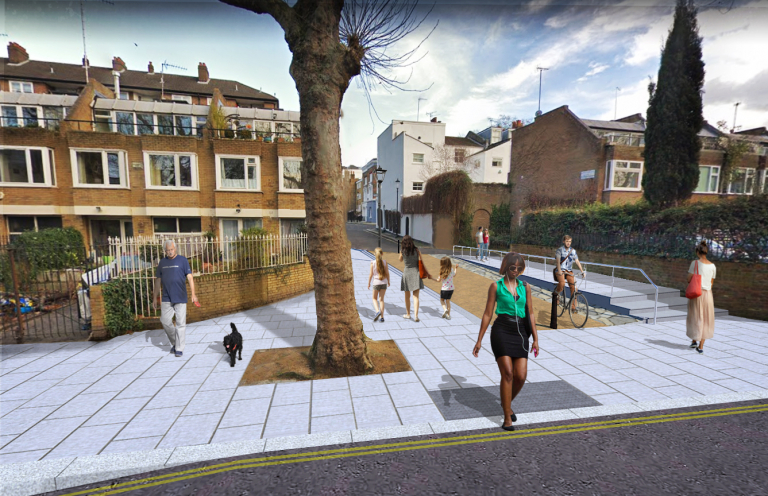
Walmer Road and Portland Road
Last updated: 29 November 2019

